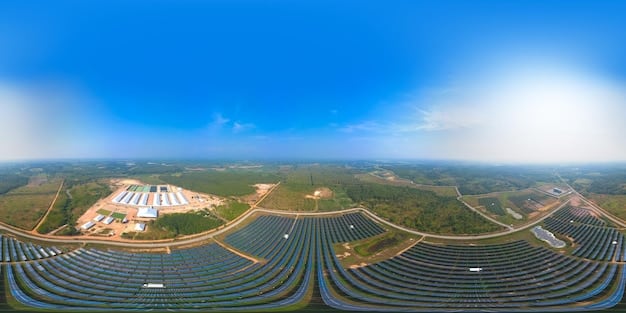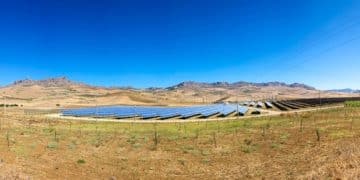Renewable Energy: Reducing Your Carbon Footprint and Saving the Planet

The environmental benefits of renewable energy are vast, primarily reducing carbon emissions, combating climate change, and fostering sustainable living by utilizing resources like solar, wind, and hydro power.
The urgency to combat climate change has put the environmental benefits of renewable energy: reducing your carbon footprint at the forefront of global discussions. Shifting from fossil fuels to sustainable sources like solar, wind, and hydro power is critical for a healthier planet. Let’s explore the compelling advantages of embracing renewable energy and how it contributes to a greener future.
Understanding the Environmental Impact of Energy Sources
To fully appreciate the environmental benefits of renewable energy, it’s essential to understand the impact of traditional energy sources. Fossil fuels, such as coal, oil, and natural gas, have been the backbone of global energy production for centuries. However, their extraction, processing, and combustion have significant environmental consequences.
The Detrimental Effects of Fossil Fuels
Fossil fuels release large quantities of greenhouse gases into the atmosphere, which contribute to global warming and climate change. These gases trap heat, leading to rising temperatures, extreme weather events, and sea-level rise. Additionally, the extraction and transportation of fossil fuels can cause habitat destruction and pollution.
- Air Pollution: Burning fossil fuels releases pollutants that degrade air quality and pose health risks.
- Water Contamination: Oil spills and coal mining can contaminate water sources, harming aquatic life and human health.
- Habitat Destruction: Extracting fossil fuels often involves deforestation and disruption of natural habitats.

By understanding these impacts, we can see why the shift to renewable energy is not just an option, but a necessity for safeguarding our planet.
The Core Environmental Benefits of Renewable Energy
Renewable energy offers a multitude of environmental benefits that address the drawbacks of fossil fuels. These advantages range from reducing greenhouse gas emissions to conserving natural resources and promoting biodiversity. Here are some core benefits:
Reduced Greenhouse Gas Emissions
The primary environmental benefit of renewable energy is its ability to reduce greenhouse gas emissions. Unlike fossil fuels, renewable sources like solar, wind, and hydro power produce little to no emissions during operation. This helps mitigate climate change by decreasing the concentration of heat-trapping gases in the atmosphere.
Switching to renewable energy sources can significantly lower your carbon footprint. By choosing to power your home or business with solar panels or wind energy, you directly reduce the amount of carbon dioxide and other pollutants released into the air.
Improved Air Quality
Renewable energy sources don’t emit harmful pollutants that degrade air quality. This leads to cleaner air, which has significant health benefits, especially for those with respiratory conditions. Cleaner air also reduces the occurrence of smog and other forms of air pollution that can damage ecosystems.
- Fewer Respiratory Issues: Reduced air pollution leads to fewer cases of asthma and other respiratory illnesses.
- Healthier Ecosystems: Cleaner air supports healthier plant life and reduces the impact of acid rain.
- Reduced Smog: Renewable energy helps minimize the formation of smog in urban areas.
Renewable energy provides cleaner, healthier environments by reducing the environmental impact of fossil fuel consumption.
Diving Deep: Specific Renewable Energy Sources and Their Impacts
Each renewable energy source has its unique environmental impact. Understanding these differences can help us make informed decisions about which sources to prioritize and how to mitigate any potential drawbacks.
Solar Energy
Solar energy harnesses the power of the sun to generate electricity. Solar panels convert sunlight into electricity without emitting pollutants or greenhouse gases. Solar energy is one of the cleanest forms of renewable energy, making it an excellent choice for reducing your carbon footprint.
Solar energy’s biggest challenges include land use and the materials required to produce solar panels. Responsible siting and recycling programs can minimize these impacts.
Wind Energy
Wind energy converts the kinetic energy of wind into electricity using wind turbines. Wind turbines produce clean electricity without emitting pollutants or greenhouse gases. Wind energy is a cost-effective and scalable renewable energy source.
Potential drawbacks of wind energy include visual impact and potential harm to birds and bats. Careful siting and mitigation strategies, such as using bird-friendly turbine designs, can minimize these impacts.
Hydropower
Hydropower harnesses the energy of flowing water to generate electricity. Hydroelectric dams can provide a reliable source of renewable energy. However, they can also have significant environmental impacts.
- Habitat Disruption: Dams can alter river ecosystems and disrupt fish migration patterns.
- Water Quality Changes: Reservoirs behind dams can experience changes in water temperature and oxygen levels.
- Sediment Trapping: Dams can trap sediment, which can affect downstream ecosystems and coastal areas.
Modern hydropower projects focus on mitigating these impacts through fish ladders, environmental flows, and other conservation measures.

Conserving Natural Resources and Ecosystems
Another critical environmental benefit of renewable energy is the conservation of natural resources and ecosystems. Traditional energy sources often require extensive extraction and transportation processes that can degrade landscapes and harm wildlife.
Reduced Resource Depletion
Renewable energy sources rely on naturally replenishable resources. Solar, wind, and hydro power do not deplete finite reserves like fossil fuels. By transitioning to renewable energy, we can conserve these resources for future generations and reduce the environmental impacts associated with their extraction.
This shift also reduces the need for environmentally damaging practices such as mountaintop removal coal mining and deep-sea oil drilling.
Protecting Ecosystems and Biodiversity
Renewable energy can help protect ecosystems and biodiversity by minimizing habitat destruction and pollution. Unlike fossil fuel extraction, renewable energy facilities can often coexist with natural environments. For example, solar farms can be designed to provide habitat for pollinators, and wind farms can be sited to avoid sensitive bird migration routes.
- Habitat Preservation: Renewable energy projects can be designed to minimize habitat disruption and preserve biodiversity.
- Reduced Pollution: Renewable energy sources produce little to no pollution, which helps protect ecosystems from harmful contaminants.
- Climate Change Mitigation: By reducing greenhouse gas emissions, renewable energy helps mitigate climate change, which poses a significant threat to ecosystems and biodiversity.
Investments in renewable energy contribute to the health and resilience of our natural world.
Enhancing Energy Security and Independence
Beyond the direct environmental benefits, renewable energy also enhances energy security and independence. Relying on diverse, domestic energy sources reduces our dependence on foreign oil and improves our resilience to energy price fluctuations and geopolitical instability.
Diversifying Energy Sources
Renewable energy sources can diversify our energy mix, reducing our vulnerability to disruptions in the supply of fossil fuels. By developing a mix of solar, wind, hydro, and other renewable energy sources, we can create a more resilient and secure energy system.
This diversification also promotes technological innovation and economic growth in the renewable energy sector.
Creating Local Jobs and Economic Opportunities
The renewable energy sector creates local jobs and economic opportunities. Manufacturing, installing, and maintaining renewable energy facilities require a skilled workforce. Investments in renewable energy can stimulate economic growth and create jobs in communities across the country.
- Job Creation: The renewable energy sector is a growing source of employment, offering jobs in manufacturing, installation, maintenance, and research.
- Economic Development: Renewable energy projects can bring economic benefits to rural communities through land lease payments, tax revenues, and job creation.
- Innovation and Entrepreneurship: The renewable energy sector fosters innovation and entrepreneurship, driving the development of new technologies and business models.
Supporting renewable energy drives economic growth and strengthens our energy security.
Policy and Support for Renewable Energy Adoption
Government policies play a crucial role in promoting the adoption of renewable energy. Incentives, regulations, and investments in research and development can accelerate the transition to a cleaner energy future.
Incentives and Subsidies
Incentives and subsidies can make renewable energy more affordable and competitive. Tax credits, rebates, and grants can reduce the upfront costs of installing solar panels, wind turbines, and other renewable energy systems. Feed-in tariffs can provide guaranteed payments for electricity generated from renewable sources.
These policies help level the playing field and encourage individuals and businesses to invest in renewable energy.
Renewable Energy Standards
Renewable energy standards (RES) require utilities to generate a certain percentage of their electricity from renewable sources. These standards create a market for renewable energy and drive investment in new renewable energy projects. They also promote technological innovation and reduce reliance on fossil fuels.
- Market Creation: RES policies create a demand for renewable energy, encouraging utilities to invest in renewable energy projects.
- Reduced Emissions: By requiring utilities to use renewable energy, RES policies help reduce greenhouse gas emissions and improve air quality.
- Technological Innovation: RES policies incentivize utilities and developers to adopt new and innovative renewable energy technologies.
Strong policy frameworks are essential for achieving our renewable energy goals.
| Key Point | Brief Description |
|---|---|
| ☀️ Reduced Emissions | Renewable energy minimizes greenhouse gas emissions, combating climate change. |
| 💨 Improved Air Quality | Renewable sources do not release harmful pollutants, leading to healthier air. |
| 🌱 Conserved Resources | Renewable energy relies on naturally replenishing resources, unlike fossil fuels. |
| ⚡ Energy Security | Diversifying energy sources reduces dependency on foreign oil and enhances resilience. |
Frequently Asked Questions
▼
The main types include solar, wind, hydro, geothermal, and biomass. Solar uses sunlight, wind uses the kinetic energy of the wind, hydro uses flowing water, geothermal uses Earth’s internal heat, and biomass uses organic matter.
▼
Renewable energy sources produce little to no greenhouse gas emissions during operation. By replacing fossil fuels with renewables, we reduce the amount of carbon dioxide and other pollutants released into the atmosphere.
▼
Solar energy is clean, abundant, and reduces dependence on fossil fuels. It can also lower electricity bills, increase property value, and create jobs in manufacturing, installation, and maintenance.
▼
Challenges include visual impact, noise, and potential harm to birds and bats. These impacts can be mitigated through careful siting, bird-friendly turbine designs, and other conservation measures.
▼
Governments can use incentives like tax credits and subsidies, establish renewable energy standards, invest in research and development, and implement policies that support the deployment of renewable energy technologies.
Conclusion
Embracing renewable energy offers a pathway to a cleaner, more sustainable future. The environmental benefits of renewable energy, from reducing carbon emissions to conserving natural resources, are substantial. By investing in renewable energy and supporting policies that promote its adoption, we can create a healthier planet for ourselves and future generations.





